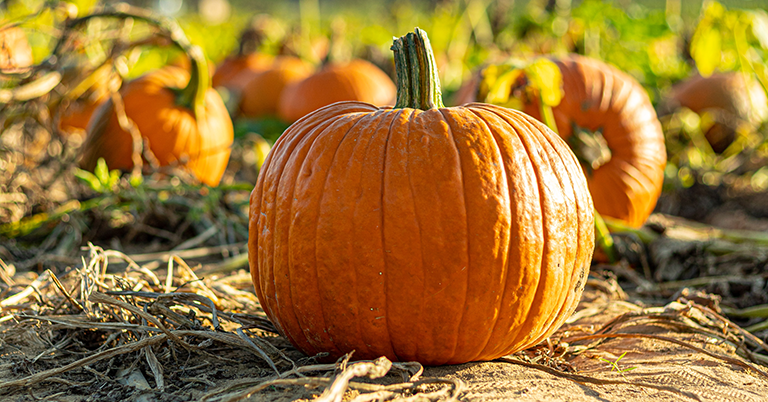Growing pumpkins is a real delight. It’s so much fun to watch the vines slowly creep across your garden space, see the large, yellow and orange flowers open up and attract bees, and then green-at-first pumpkins start to develop. We’re going to teach you everything you need to know about these awesome squash. Squash-ome, if you will! Let’s talk about how to grow pumpkins.
Pumpkins and humans go way back. They have been cultivated in North America for the last 5,000 years! So it’s no wonder that we still love growing these versatile vegetables.
Read More: When to Plant Vegetables for Your Most Successful Garden Yet
How to grow pumpkins
Pumpkins have an important place in my garden. I use them in pies, as jack-o-lanterns, and when my jack-o-lanterns start to get squishy and rot, I feed them to my chickens for a healthy chicken snack! Some things you should know about growing pumpkins:
- Pumpkins require full sun
- They can handle any soil pH
- Pumpkins do like a bit of manure or compost
- They begin to flower during the summer
- They are hardy for planting zones 3-9
Growing pumpkins from seed
Growing pumpkins from seed is simple and a lot of fun. I love how large the seedlings are and how quickly they develop mature-looking pumpkin leaves. Let’s dig in on how to grow pumpkins from seeds.
- Start pumpkin seeds indoors between 2 and 4 weeks before last frost
- Plant seeds approximately one inch deep
- Seedlings will germinate in about 5-10 days
- Once the danger of frost has passed, your seedlings can be transplanted
- Plant pumpkins on pumpkin hills in rows separated by 4-8 feet.
- Planting pumpkin seedlings on a hill increases the soil’s temperature, which is vital for young pumpkin seedlings
- Plant 4 or 5 seedlings per hill. After two weeks, thin to 2 per hill. Snip them so not to disturb root systems of neighboring seedlings
- Do your best to control weeds around your pumpkin plants. Mulch can help with this.
Growing healthy pumpkins
There are some things you’ll want to keep in mind when your pumpkin vines begin producing pumpkins.
- Pumpkins have a high demand for nutrients. You will want to fertilize several times during the summer using manure or compost.
- Once several pumpkins have begun to develop, pinch off any additional pumpkins that begin to grow. This will help the vine use all of its energy developing a handful of quality fruit.
- If an even shape is important to you, gently turn your pumpkins periodically.
Read More: How To Carve A Galaxy Pumpkin For A Stellar Halloween
When to harvest your pumpkins
Knowing when to harvest your pumpkins means the difference between a delicious pie and an empty pie tin full of disappointment and broken dreams. Here’s what you need to know about harvesting pumpkins.
- Don’t rush it. Pumpkins are ripe when they turn a deep orange color (for orange varieties)
- The pumpkin should sound hollow when gently thumped by a finger.
- If the pumpkin plant has begun to die back, your pumpkins are definitely ready for harvest
- Carefully cut the pumpkins from the vine using shears and handle them gingerly
And with that, you’ve successfully grown pumpkins! Enjoy carving them, roasting their seeds, making pies and bread, and whatever else you plan to do with your pumpkins!




